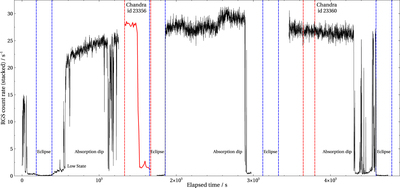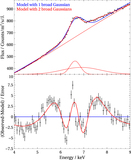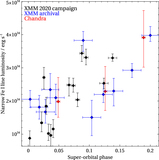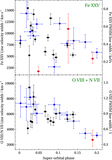Image Details

Caption: Figure 2.
XMM-Newton/RGS (stacked) 0.35–1.8 keV and Chandra High Energy Transmission Gratings (HETG; 1−9 keV) light curves from the 2020 August campaign on Her X-1, with a resolution of 100 s. The campaign consisted of three full-orbit XMM-Newton observations as well as two shorter Chandra observations. Aside from the high state and a brief low flux period, we observed one full and two partial eclipses of Her X-1 by the secondary and four absorption dipping periods. The 0.3–10 keV European Photon Imaging Camera (EPIC) pn light curve has a very similar shape to the RGS light curve, but the absorption dips are less pronounced due to the higher energy coverage of pn. Chandra count rate during observation 23356 was scaled by the RGS/HETG count ratio during observation 23360 with simultaneous coverage of both instruments. The light curve of Chandra observation 23360 is not shown, as the same time interval is covered by XMM-Newton. The elapsed time of 0 corresponds to MJD 59071.69035.
Copyright and Terms & Conditions
© 2022. The Author(s). Published by the American Astronomical Society.












